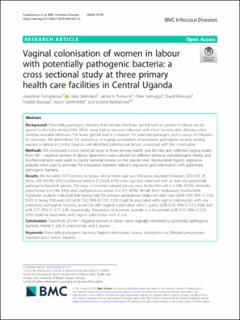| dc.contributor.author | Tumuhamye, Josephine | |
| dc.contributor.author | Steinsland, Hans | |
| dc.contributor.author | Tumwine, James K. | |
| dc.contributor.author | Namugga, Olive | |
| dc.contributor.author | Mukunya, David | |
| dc.contributor.author | Bwanga, Freddie | |
| dc.contributor.author | Sommerfelt, Halvor | |
| dc.contributor.author | Nankabirwa, Victoria | |
| dc.date.accessioned | 2021-07-15T09:50:14Z | |
| dc.date.available | 2021-07-15T09:50:14Z | |
| dc.date.created | 2020-10-08T11:30:24Z | |
| dc.date.issued | 2020-01-31 | |
| dc.identifier.issn | 1471-2334 | |
| dc.identifier.uri | https://hdl.handle.net/11250/2764492 | |
| dc.description.abstract | Background: Potentially pathogenic bacteria that colonise the lower genital tract of women in labour can be passed to the baby during birth. While many babies become colonised with these bacteria after delivery, a few develop neonatal infections. The lower genital tract is a reservoir for potential pathogens and a source of infection for neonates. We determined the prevalence of vaginal colonisation of potentially pathogenic bacteria among women in labour in Central Uganda and identified potential risk factors associated with this colonisation.
Methods: We conducted a cross sectional study at three primary health care facilities and collected vaginal swabs from HIV-1 negative women in labour. Specimens were cultured on different selective microbiological media, and biochemical tests were used to classify bacterial isolates on the species level. Multivariable logistic regression analyses were used to estimate the association between relevant exposures and colonisation with potentially pathogenic bacteria.
Results: We recruited 1472 women in labour whose mean age was 24.6 years (standard deviation [SD] 4.9). Of these, 955 (64.9%; 95% Confidence Interval [CI] 62.4, 67%) were vaginally colonised with at least one potentially pathogenic bacterial species. The most commonly isolated species were Escherichia coli (n = 508; 34.5%), Klebsiella pneumoniae (n = 144; 9.8%) and Staphylococcus aureus (n = 121; 8.2%). Results from exploratory multivariable regression analyses indicated that having had ≥5 previous pregnancies (adjusted odds ratio [aOR] 0.59; 95% CI 0.35, 0.97) or being ≥30 years old (aOR 1.52; 95% CI 1.03, 2.23) could be associated with vaginal colonisation with any potentially pathogenic bacteria, as well as with vaginal colonisation with S. aureus (aOR 0.33; 95% CI 0.12, 0.88, and aOR 2.17; 95% CI 1.17, 4.00, respectively). Possession of domestic animals in a household (aOR 0.57; 95% CI 0.35, 0.92) could be associated with vaginal colonisation with E. coli.
Conclusions: Two-thirds of HIV-1 negative women in labour were vaginally colonised by potentially pathogenic bacteria, mainly E. coli, K. pneumoniae, and S. aureus. | en_US |
| dc.language.iso | eng | en_US |
| dc.publisher | BioMed Central | en_US |
| dc.rights | Navngivelse 4.0 Internasjonal | * |
| dc.rights.uri | http://creativecommons.org/licenses/by/4.0/deed.no | * |
| dc.title | Vaginal colonisation of women in labour with potentially pathogenic bacteria: A cross sectional study at three primary health care facilities in Central Uganda | en_US |
| dc.type | Journal article | en_US |
| dc.type | Peer reviewed | en_US |
| dc.description.version | publishedVersion | en_US |
| dc.rights.holder | Copyright the authors | en_US |
| dc.source.articlenumber | 98 | en_US |
| cristin.ispublished | true | |
| cristin.fulltext | original | |
| cristin.qualitycode | 1 | |
| dc.identifier.doi | 10.1186/s12879-020-4821-6 | |
| dc.identifier.cristin | 1838166 | |
| dc.source.journal | BMC Infectious Diseases | en_US |
| dc.relation.project | Norges forskningsråd: 234500 | en_US |
| dc.relation.project | Norges forskningsråd: 223269 | en_US |
| dc.identifier.citation | BMC Infectious Diseases. 2020, 20, 98. | en_US |
| dc.source.volume | 20 | en_US |

